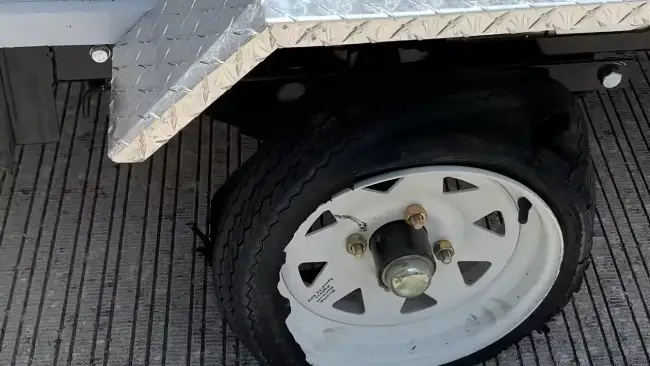Last Updated on July 26, 2023
Trailer tires are an essential component of trailers used for hauling heavy loads. However, these tires are not uncommon to blow out, causing a potential safety hazard and a significant inconvenience for the driver.
There are several reasons why trailer tires may blow out, including overloading, underinflation, overinflation, poor tire quality, and excessive heat. Understanding the causes of these tire failures is essential to prevent them from happening and ensure a safe and efficient trailer operation.
We’ll cover tire failure factors like weight capacity, pressure, and temperature today. You’ll also get handy tips on handling a blown-out tire and keeping your trailer tires in top shape for longevity and optimal performance.
Why Do My Trailer Tires Keep Blowing Out: 5 Reasons with Preventions
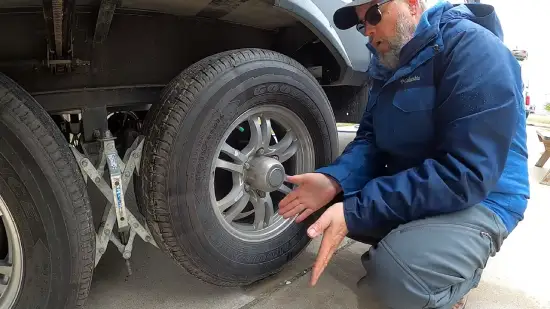
Trailer tire blowouts can be a dangerous problem for drivers. It is essential to understand the potential causes and take appropriate precautions to prevent tire blowouts while driving a trailer.
Among the most common causes are:
- Overloading and Underinflated Tires
- Aging and Rot, Despite Good Tread
- Small Wheels and Cheap Tires
- High RPM and Tire Flexing From Smaller Wheels
- Traveling With a Loaded Trailer on Hot Roads
1. Overloading and Underinflated Tires
Improperly inflated tires and exceeding the weight capacity are common causes of tire blowouts on trailers. Overloading the trailer or underinflating the tires can cause the tires to generate excessive heat, leading to tire failure.
In addition, underinflated tires can cause the tire sidewalls to flex excessively, leading to heat buildup and reduced tire life.
Follow the trailer manufacturer’s recommended weight capacity and ensure the tires are inflated properly to prevent tire blowouts.
Here are three tips to help prevent tire blowouts:
- Check the weight of the load before towing to ensure that it is within the trailer’s weight capacity.
- Check the tire pressure regularly, at least once a month or before every trip, and adjust the pressure as needed to match the manufacturer’s recommendations.
- Consider using a tire pressure monitoring system (TPMS) to alert you to any changes in tire pressure while driving. This can help you identify potential problems before they become serious and prevent tire blowouts.
2. Aging and Rot, Despite Good Tread
Despite having good tread, aging and rot can still lead to tire failure on a vehicle. This is because tires are made of rubber, which naturally deteriorates over time. Exposure to sunlight, heat, and chemicals further accelerates this process, resulting in cracks, dryness, and brittleness.
When this happens, the rubber loses its elasticity and strength, making it prone to punctures, blowouts, and tread separation. Moreover, the internal components of the tire, such as the steel belts, nylon plies, and bead wires, can also corrode and weaken, leading to structural failure.
To prevent tire failure due to aging and rot, it is important to regularly inspect and replace your tires, even if they appear to be in good condition. A general rule of thumb is to replace tires over six years old, regardless of their mileage or tread depth.
Tires may need to be replaced more frequently if your trailer is exposed to harsh conditions, such as frequent use, heavy loads, or extreme temperatures. Also, you can protect your tires by storing them in a cool and dry place, using tire covers, and avoiding exposure to chemicals and UV rays.
3. Small Wheels and Cheap Tires
The use of small wheels and cheap tires can have a significant impact on the performance and safety of a vehicle. Small wheels are more prone to wear and tear because they rotate more times than larger wheels to travel the same distance. This can lead to premature tire failure, especially if the tires are of poor quality.
Additionally, small wheels have less surface area in contact with the road, affecting the vehicle’s stability and handling. This can be dangerous, especially when driving on uneven or slippery surfaces.
Cheap tires are also a common cause of tire blowouts. Poor-quality tires are more likely to have manufacturing defects, such as weak spots or poor adhesion between the layers of the tire. They may also have thinner sidewalls, making them more susceptible to punctures and blowouts.
Cheap tires also tend to have lower-quality rubber, which can wear out more quickly and lead to reduced traction and braking ability. Investing in high-quality, properly sized tires can help prevent blowouts and improve the overall safety and performance of a vehicle.
4. High RPM and Tire Flexing From Smaller Wheels
Excessive RPM and reduced radius of smaller wheels result in tire flexing, leading to decreased stability and increased wear. This phenomenon occurs because the wheel’s rotation causes the tire to deform as it compresses under the weight of the trailer and its cargo.
As the tire flexes, it generates heat, which can cause the tire to wear more quickly. Furthermore, the tire’s sidewalls may become weakened, which could ultimately lead to a blowout.
To mitigate the effects of excessive RPM and reduced wheel radius, it is important to consider the following factors:
- Load distribution: Uneven weight distribution can cause one tire to carry more weight than the others, leading to increased flexing and wear.
- Tire inflation: Proper tire inflation can help reduce tire flexing and heat generation, preventing premature wear.
- Tire quality: Investing in high-quality tires with stiffer sidewalls can help reduce flexing and improve stability.
- Wheel size: Increasing the wheel size can reduce the amount of tire flexing and improve stability, ultimately increasing the lifespan of the tires.
5. Traveling With a Loaded Trailer on Hot Roads
Traveling with a loaded trailer on hot roads during hot days can be a challenging task that requires careful consideration of various factors. One of the main factors to consider is the effect of high temperatures on the tires. When the temperature rises, the air inside the tire expands, increasing the pressure.
If the pressure exceeds the recommended level, the tire can blow out. This is particularly true for trailers that are heavily loaded, as the weight increases the pressure inside the tire. Therefore, ensuring that the tires are properly inflated and the recommended pressure levels are not exceeded is crucial.
Another factor to consider is the condition of the tires. Over time, tires can become worn out, and the tread can wear down, increasing the risk of a blowout. This is especially true for trailers used frequently and subject to a lot of wear and tear.
Therefore, inspecting the tires regularly and replacing them when necessary is important. Additionally, it is essential to ensure that the tires are the correct size and type for the trailer, as using the wrong tires can increase the risk of a blowout.
What Do You Do if Your Trailer Tire Blows Out?
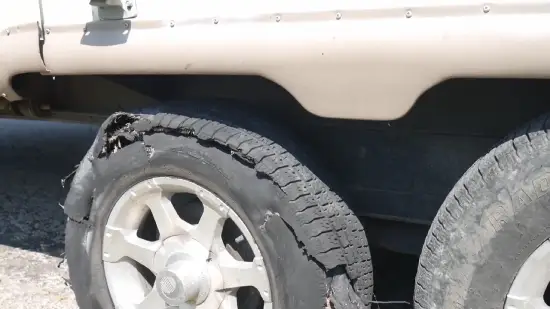
In the event of a trailer tire blowout, it is important to stay calm and maintain control of the vehicle.
One: Stay Calm
Remaining calm and composed is crucial in the event of a blown-out tire, allowing for a safer response and minimizing the risk of further damage or injury. It is important to remember that a blown-out tire can be startling, but it is imperative to stay focused and avoid panicking.
Keep these things in mind if you blow a tire:
- Keep your hands firmly on the steering wheel and maintain vehicle control.
- Gradually ease off the accelerator and let the vehicle slow down naturally.
- Do not slam on the brakes, as this can cause the vehicle to swerve or lose control.
Note: Remember, staying calm and composed can help you make the right decisions and avoid worsening the situation.
Two: Maintain Control
To effectively handle a blown-out tire, maintaining a secure grip on the steering wheel is vital for controlling the trailer and avoiding further harm. When the driver senses a tire blowout, they should keep their hands on the steering wheel and try to maintain control of the trailer.
It is crucial to remain calm and not apply the brakes immediately, as this could cause the vehicle to skid. Instead, the driver should take their foot off the accelerator and allow the vehicle to slow down gradually.
In addition, the vehicle may pull to one side when a tire blows out, so the driver must be prepared for this sudden change in handling. If the driver is not prepared, they may lose control of the vehicle, leading to a serious accident. Therefore, they should be alert and ready to steer the vehicle in the opposite direction of the pull.
Three: Gradually Release the Accelerator
Gently easing off the accelerator pedal like a feather floating down can help prevent the trailer from swaying or skidding when a blown-out tire occurs. This is because sudden braking or acceleration can cause an imbalance in the weight distribution of the trailer, which can lead to a loss of control.
Gradually releasing the accelerator helps to maintain a stable and balanced drive, allowing the vehicle to slow down without causing any sudden movements.
To further prevent trailer tire blowouts, it’s crucial to maintain proper tire pressure and regularly inspect the tires for any signs of wear and tear. The trailer should also be loaded evenly, with the weight distributed evenly. An unbalanced load can cause excess strain on the tires and lead to blowouts.
Four: Find a Safe Spot to Pull Over
Identifying a safe area to pull over is crucial after regaining control and slowing down the vehicle following a trailer tire blowout. It is important to scan the surroundings for a wide shoulder or a parking lot away from traffic. Signaling other drivers that you’re stopping is crucial once you’ve found a safe spot.
This can be done by turning on the hazard lights, honking the horn, or using hand signals. When selecting a safe spot to pull over, it is important to consider the weight distribution of the trailer and the vehicle. Weight distribution hitches to ensure that the trailer’s weight is evenly distributed across all wheels.
Additionally, it is essential to check the tire pressure and tread depth of all tires before starting a journey. The following table provides a guide to tire pressure and tread depth for different types of vehicles:
| Vehicle Type | Tire Pressure (psi) | Tread Depth (mm) |
| Passenger Car | 32-35 | 3-4 |
| Light Truck | 35-40 | 4-5 |
| Heavy Truck | 80-100 | 6-8 |
Five: Activate Hazard Lights
When experiencing a tire blowout while towing a trailer, turning on the hazard lights serves as a symbol of caution and safety for other drivers on the road. Hazard lights are designed to alert other drivers that there is a potential hazard on the road and that they should proceed with caution.
By activating the hazard lights, you are letting other drivers know that you are experiencing an issue and are pulling over to address the problem. Whenever you have a tire blowout and are towing a trailer, turn on the hazard lights.
Not only does this help ensure your own safety, but it also helps prevent accidents involving other drivers. In addition to turning on the hazard lights, you should also try to find a safe spot to pull over as quickly as possible. As a result, you’ll reduce the risk of further damage to your vehicle or trailer.
What’s the life expectancy of trailer tires?
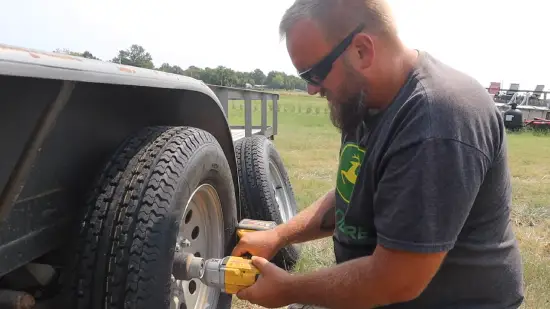
Like the lifespan of a person, trailer tires also have a finite lifespan that varies according to the manufacturer’s recommendations and maintenance conditions. On average, a trailer tire can last up to five years under normal use and proper maintenance.
Note, however, that this is just an estimate, and different manufacturers may recommend different sizes and types of tires.
To ensure the longevity of trailer tires, it is important to follow the manufacturer’s recommendations for maintenance and replacement. Here are some factors that can affect the life expectancy of trailer tires:
- Proper inflation: Underinflated or overinflated tires can cause excessive wear and tear and reduce the tire’s lifespan.
- Load capacity: Overloading the trailer can cause excessive tire stress and lead to premature failure.
- Storage conditions: Exposure to extreme temperatures and direct sunlight can cause the tires to deteriorate faster.
- Regular inspection: Inspecting the tires for signs of wear and damage can help detect any issues early on and prevent blowouts while on the road.
Can trailer tires handle a certain amount of weight?
Trailer owners must be aware of the load range of their tires, as it determines the amount of weight that the tire can safely carry. Single-axle trailer tires can carry 100% of the load rating, meaning that if the tire has a load range of C, it can safely carry up to 3,640 pounds.
However, for double-axle trailers, the load range needs to be decreased by 12%. This means that a tire with a load range of C on a double-axle trailer can carry up to 3,203 pounds safely. It is essential to ensure that the weight of the trailer and its contents does not exceed the load range of the tires.
Overloading the tires can cause them to overheat, leading to a blowout or failure. Additionally, factors such as tire age, maintenance, and road conditions can also contribute to tire failure.
Consequently, trailer owners need to regularly check their tires’ load range and make sure their trailer and contents don’t exceed the tire’s capacity.
How much temperature does it take for trailer tires to fail?
Excessive tire temperature can cause structural damage and tread reversion, which can lead to tire failure and pose a safety hazard. The temperature at which a tire will fail depends on various factors, such as the type of tire, its load capacity, and the speed at which it is being driven.
However, most experts consider 195 degrees Fahrenheit as the “line in the sand” regarding tire temperature. Beyond this point, the temperature will start impacting tire life. At 250 degrees Fahrenheit, a tire will start to lose structural strength, and could begin experiencing tread reversion, and the tire will begin to lose strength.
Below is a table that shows the temperature at which tires fail based on speed and load capacity. This table highlights the importance of maintaining the tire temperature below 195 degrees Fahrenheit to ensure maximum tire life and prevent tire failure.
As can be seen from the table, a tire with a load capacity of 1,000 pounds driven at 55 mph can fail at a temperature of 195 degrees Fahrenheit. Similarly, a tire with a load capacity of 2,000 pounds and driven at 65 mph can fail at a temperature of 220 degrees Fahrenheit.
Can you drive a trailer with a blown tire?
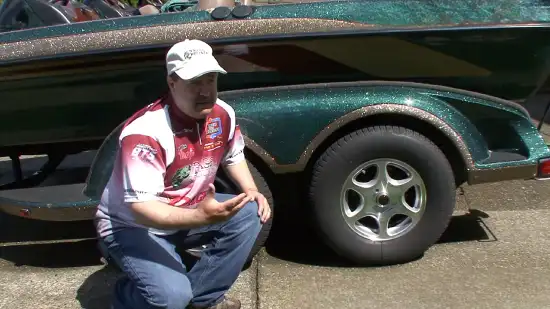
Driving a trailer with a blown tire may be necessary in certain situations, even though it can increase rolling resistance and decrease grip. When a trailer experiences a blown tire, it can be difficult to control and maneuver. As soon as possible, the driver needs to turn on the hazard lights and pull over.
If a spare tire is available, the driver can replace the blown tire; if not, the driver may have to continue driving with the blown tire. It is important to note that driving a trailer with a blown tire is not recommended.
The increased rolling resistance can cause the vehicle to work harder, resulting in decreased fuel efficiency and potential damage to other vehicle parts. Additionally, the decreased grip can increase the risk of accidents in wet road conditions.
If possible, it is best to avoid driving a trailer with a blown tire and instead seek immediate repair or replacement of the tire.
Avoiding and Preventing Trailer Tire Blowouts
It’s no secret that experiencing a trailer tire blowout can be an incredibly frustrating and downright dangerous situation for drivers. To avoid such an occurrence, there are a few formal steps that can be taken to help ensure a safe and smooth trip.
Firstly, it’s important to be mindful of the causes of trailer tire blowouts, including overloading, underinflation, and excessive heat buildup. But in the event that a tire does blow out while driving, remaining calm and pulling over to a safe location is crucial.
Additionally, keep in mind that tire life can vary depending on usage, storage conditions, and maintenance. This means that regular tire maintenance, such as checking air pressure and inspecting for damage, is essential in preventing blowouts.

